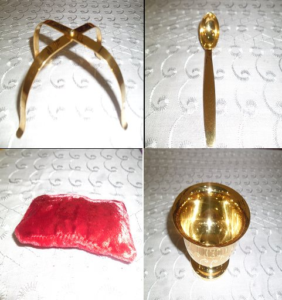Kaukbo (Astaric), Gmourtho (Cushion), Tharvodho (Spoon) and Mshmshoniso (Cup)

Astaric or Star (Kaukbo)
This is made of silver or gold, in the shape of a cross like, star with the four ends bending downwards and is used to support the veil above the Paten, so that the veil (Kabilana) may not touch the Holy Bread. It is the symbol of the star that stood over the manger in Bethlehem at the time of Jesus’ birth (Mt 2: 2, 9- 11).
Cushion (Gmourtho/ Esphugo) – Live Coal
This is a sponge or a small cushion of fine texture, placed to the left of Thabilitho. It is about 3 inches long and ½ inch broad an inch thick and red in colour. It is compared to the live coal placed on Isaiah’s lips (Is. 6: 1-7). It is used as a sacramental spoon rest and also to fingers of the celebrant after touching the body and blood. It is also used to wipe the lips of infants after communion and also to wipe the paten and chalice, signifying a more careful handling of the bread (Body) and wine (Blood). It is also used to wipe and clean the Holy vessels, Tharvodo (spoon) and the Kaukubo (Star).
It symbolizes the throne of God. After the Institution of Holy Eucharist and blessing Bread and Wine, the celebrant raises Gmurtho and Spoon to be visible to the congregation for which there are many interpretations. It symbolizes the sponge the soldiers used to feed Christ with sour wine during His passion on the cross. “… and taking a sponge, he filled it with sour wine, and put it on a reed, and gave Him a drink” (Matthew 27: 48).

Sacramental Spoon (Tharvodho)
This sacramental spoon is usually made of the same metal as the holy vessels, gold or silver. It is used to take the Gmurtho (small piece of bread), cast into the Chalice at the time of fraction and to administer the Holy Eucharist from the chalice. It is by this, the priest partakes the Sacred Elements and also used to administer the Holy Body and Blood to those who receive it. This is also called ‘Kalbatho” and signifies the tongs with which the Seraph placed a live coal on Isaiah mouth in a vision. “One of the seraphim flew to me and in his hand was a live coal which he had taken with the tongs off the altar. And he touched my mouth …” (Is. 6: 6-7)
The Washing Cup (Mshmshoniso/Mshamshanitho)
It is like a finger bowl, kept at the left side of the Holy vessels. It is used for mixing the wine with water during the preparatory service, before pouring into the Chalice. It is also used to keep water to wash the tips of the fingers, after handling the Holy Body and Holy Blood and at the conclusion of the celebrant’s communion. Water is taken in it for the washing of the Holy vessels at the end of the communion. It represents the women disciples ‘deaconesses’, who served Jesus during the public ministry.
0 Comments